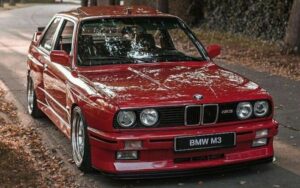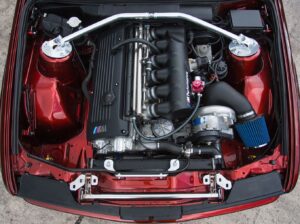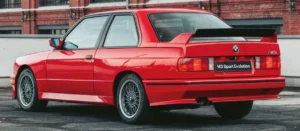BMW E30 M3: The legend that moved the world
2. The 1980s: A new kind of war
3. The mission
4. Engineering perfection: The M3 takes shape
7. Conclusion
The birth of balance
To understand why the M3 became an icon, you have to understand BMW’s obsession with precision.
In the 1920s, before the company built cars, BMW made aircraft engines—engineering marvels that powered planes higher and faster than anyone thought possible. Among those early engineers was Willy Messerschmitt, a man who would later design one of the most agile and deadly aircraft ever built: the Bf 109.
The Bf 109 wasn’t the most powerful or heavily armed plane of World War II. What made it legendary was balance—an intricate harmony between weight, speed, and control. In the hands of a skilled pilot, it became an unstoppable weapon.
That same philosophy would later fuel another machine—one that conquered not the skies, but the asphalt.
The 1980s: A new kind of war
By the mid-1980s, the battlefield had shifted from the air to the tarmac.
Germany’s automotive giants were locked in a new arms race, not with bullets, but with horsepower. The oil crisis of the 1970s had forced manufacturers to downsize. Racing series like the Deutsche Tourenwagen Meisterschaft (DTM) demanded cars that were lightweight, efficient, and production-based.
Mercedes-Benz entered the fight with its 190E, an elegant but ferocious touring car. Audi had its all-wheel-drive revolution. Ford was leading with its Sierra Cosworth.
And BMW? They were behind.
Their big, heavy coupes were too slow, too thirsty, too old-school.
But inside BMW’s headquarters in Munich, CEO Eberhard von Kuenheim wasn’t about to accept defeat. He gave his engineers a single order:
“Build the ultimate driver’s car—and win.”
The mission
The engineers at BMW’s M Division, led by motorsport legend Paul Rosche, faced a challenge that bordered on madness.
DTM’s rules required that every race car be based on a production model—and BMW needed to sell at least 5,000 road cars to qualify.
Their candidate? The humble 3 Series, a tidy little sedan better suited for city commutes than for the Nürburgring.
It had a small engine, narrow body, and little chance against Mercedes or Ford.
So the M engineers decided to do the unthinkable.
If they had to make a race car from a production car—
they’d simply turn the production car into a race car.
Engineering perfection: The M3 takes shape
The first prototype of what would become the E30 M3 was built from the ground up with a single purpose: victory.
Under the hood, Paul Rosche designed a new engine in just 14 days. He combined the bulletproof M10 four-cylinder block with half of the legendary M88 head from the BMW M1 supercar. The result was the S14, a high-revving, 2.3-liter masterpiece producing 200 horsepower in road trim and over 300 in race spec.
Power was sent through a Getrag 5-speed dogleg gearbox—unusual for street use but perfect for racing, allowing lightning-fast shifts from second to third through tight corners.
Every panel was touched by the hand of a racer.
The M3’s fenders flared wider to fit massive tires.
The roofline, C-pillars, and rear spoiler were reshaped for aerodynamic balance.
Steel bumpers were replaced with lightweight composites.
In the end, the E30 M3 shared only a handful of parts with the standard 3 Series—hood, roof, and inner doors. Everything else was new. Everything else was built to win.
The race car You could buy
When the first M3s rolled out of BMW’s Regensburg factory in March 1986, accountants feared disaster.
They worried nobody would buy such a raw, expensive sports sedan.
Base price? Around €45,000 (adjusted for inflation).
But they were wrong.
Car enthusiasts saw the M3 not as a compromise—but as a revolution.
Here was a car that could take you to dinner on Saturday, and to the DTM podium on Sunday.
It was refined yet feral, precise yet passionate.
BMW planned to sell 5,000 units. They sold 10,000 before the factory begged for mercy.
The legend is born
The M3’s first season was a massacre.
It won the European Touring Car Championship, the World Touring Car Championship, the Australian Touring Car Championship, and—most importantly—the DTM title.
Drivers like Eric van de Poele turned the E30 M3 into a symbol of dominance.
At its peak, BMW M3s were winning a race every single day somewhere in the world.
Over its run, the E30 M3 racked up 1,436 victories, making it the most successful touring car ever built.
Conclusion
Nearly forty years later, the E30 M3 still stands as the benchmark of what a driver’s car should be: light, communicative, agile, and pure.
Its value continues to climb—mint examples now easily command over €100,000 on the collector market.
But its true worth isn’t measured in euros.
It’s measured in the goosebumps it gives you when that S14 howls past 7,000 rpm, and the way it reminds you that man and machine, when perfectly balanced, can indeed move the world.
Inspired by the analysis of our friend . Make sure you check his other videos
https://www.youtube.com/@the.squidd
Are you already a proud owner of a BMW E30? If so, check out our selection of parts for this car at the following link:
https://octoclassic.com/product-category/bmw/e30
Photo sources: Pinterest, wallpapercave.com, storage.googleapis.com










